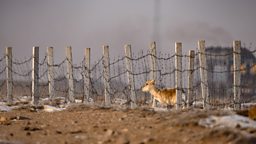Elephants in Sri Lanka
By Seth Daood, Researcher

We arrived in Sri Lanka not long before midnight, and immediately jumped into a taxi for the four-hour drive to our location. We only made one stop along the way (for ice cream-filled coconuts), before we crashed into our beds in the quiet town of Kataragama. You would have never guessed that just outside, gentle giants were roaming and getting ready for a day of hustling.
That afternoon, we went to meet our star – Raja.
On day one, an old, battered car turned up – supposedly our filming vehicle, pending some modifications. As the local crew got to work, I thought there was no way this was going to be turned into something suitable, but once the welding began, it transformed before my eyes. The ingenuity and problem-solving the crew possessed was incredible – in just a few hours we saw an old car become the finest vehicle in wildlife filmmaking. It allowed for a dynamic approach, as we needed to be able to move the camera from the back of the car to the side, depending on circumstances.
That afternoon, we went to meet our star – Raja. Although at the time, we had no idea what a star he was going to be. I had never seen an elephant before I saw Raja – and his sheer scale blew me away. Raja was a magnificent forty year-old elephant, who has been hustling by the side of the road longer than any other elephant on this highway. In fact, he had laid down the blueprint for how to get food from vehicles on the road.

The next day, filming began, and I had the absolute pleasure of working alongside the fantastic cinematographer, Justine Evans. Spending time with her was the best learning experience I have ever had, and her experience cannot be understated. In hindsight, Justine gave me a crash course in how to be the best director on location I can be.
We continually observed new complexity in Raja’s strategies for stealing food.
Each morning, without fail, at 6:00 am, we would be greeted on the road by Raja. The whole town was asleep, but Raja was ready, waiting for the meals he was going to get that day.
We continually observed new complexity in Raja’s strategies for stealing food. His methods involved being calm, but persistent. He never got angry, unlike some of the younger elephants, because he’s learnt that anger isn’t what gets you the best rewards. Instead, being a gentle giant is the scheme he has adopted. Over the three weeks that we filmed with him, I discovered a lot about the relationship between humans and elephants by being able to watch how Raja was being treated with such respect, despite causing quite a lot of trouble on the road.

Throughout my time in Sri Lanka, I learnt from our local guide, Sampath, an immense amount about the cultural importance of elephants, but being able to experience how that cultural importance feeds into everyday actions really shed a new light onto human-animal relationships for me.
...neither side of this conflict are ‘wrong’...
He told us that seventy percent of the Sri Lankan population is Buddhist, and holds that elephants are of deep importance. Before the Buddha was born, his mother dreamed of a great white elephant – it is believed that Buddha himself could have been in the form of an elephant in previous lives. Hinduism, Sri Lanka’s second largest religion, also enjoys a close association with the animals in the form of the god Ganesh.
Sampath also told us that seventy percent of elephant ranges in Sri Lanka spread into human habitats and areas, and so only thirty percent of elephant ranges are truly wild. The human-elephant balance in Sri Lanka is so delicate, and the tensions cannot be understated. Being there first-hand allowed me a new perspective, to understand that both sides of this conflict really do not want it. Whilst I do not have a solution, what became clear to me is that neither side of this conflict are ‘wrong’, both are simply doing what they can to survive.

The elephant bandit of Sri Lanka
One clever elephant has found a way to make a living from its human neighbours.



































